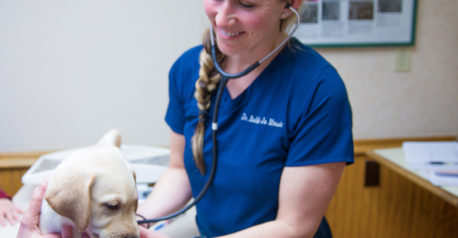Cat Cardiology
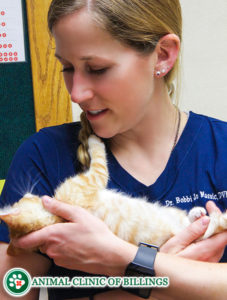
HOW A CAT’S HEART FUNCTIONS
A cat’s heart is very similar to a human’s heart in its structure and function. The heart is composed of two pumps working in concert to circulate blood through the lungs, picking up oxygen and releasing gaseous waste products, and then throughout the rest of the body to deliver oxygen to the tissues.
Each pump is composed of two chambers, called the atrium and the ventricle, separated from one another and from vessels leaving the heart by one-way valves. As these chambers contract in a coordinated fashion, they propel blood forward, either into the lungs (right side) or the rest of the body (left side).
CAUSES OF CAT HEART DISEASE
According to the AVMA or American Veterinary Medical Association, heart disease in cats will affect an estimated 1 of every 10 cats worldwide at some point in their lives. Heart disease in cats can have many causes, and may ultimately lead to congestive heart failure if not treated.
Feline heart disease in cats can be either congenital or acquired:
Congenital heart disease in Cats
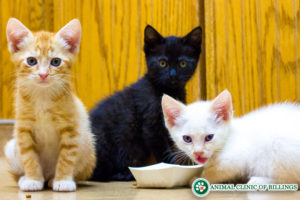
Congenital heart disease is present at birth in cats affected by it and may be inherited from the parents or may be a result of exposure to an infection, toxin, or other adverse conditions before birth.
The two most common types of cat congenital heart disease are a malformed valve and a hole in the wall that separates the two sides of the heart. Both of these conditions are discussed further below.
Acquired heart disease in Cats
Acquired, or adult-onset heart disease, often has a genetic basis and occurs in middle-aged to older cats, but can also result from an injury or infection. The most commonly-encountered type of adult-onset heart disease in cats is called Hypertrophic Cardiomyopathy. This is discussed in more detail below.
Heart disease can also be classified by the specific structures involved:
Valve Dysfunction
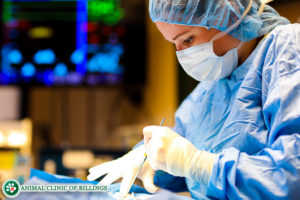 Abnormalities of the heart valves in cats are usually congenital, although infectious and degenerative causes are also possible. Healthy heart valves function to prevent the backward flow of blood as the heart pumps, ensuring that all of the blood delivered to the heart is propelled in the right direction each time the heart muscle squeezes and relaxes.
Abnormalities of the heart valves in cats are usually congenital, although infectious and degenerative causes are also possible. Healthy heart valves function to prevent the backward flow of blood as the heart pumps, ensuring that all of the blood delivered to the heart is propelled in the right direction each time the heart muscle squeezes and relaxes.
Valve diseases result in backward leakage of blood through one or more valves. Over time, this leakage causes the heart to become overloaded as it has to pump harder and faster to keep enough blood flowing in the correct direction. The backflow of blood through a leaking valve can often be heard as a murmur when a veterinarian listens to a patient’s heartbeat with a stethoscope.
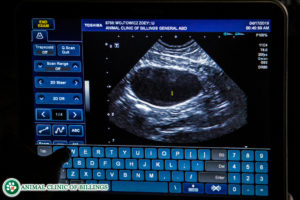 To definitively diagnose one of these diseases and determine severity, an echocardiogram (ultrasound of the heart) is performed. This allows for direct observation of valve movement and blood flow, as well as measurements of the heart chambers and strength of contractions.
To definitively diagnose one of these diseases and determine severity, an echocardiogram (ultrasound of the heart) is performed. This allows for direct observation of valve movement and blood flow, as well as measurements of the heart chambers and strength of contractions.
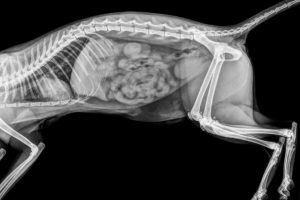 Chest X-rays, which reveal the size and external contours of the heart, can also provide information about which valve is involved based on which portion of the heart is enlarged but do not provide as much information as an echocardiogram.
Chest X-rays, which reveal the size and external contours of the heart, can also provide information about which valve is involved based on which portion of the heart is enlarged but do not provide as much information as an echocardiogram.
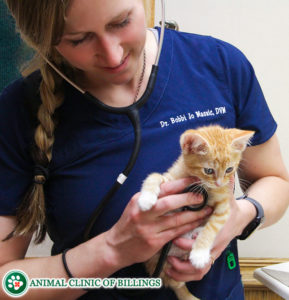
Treatment depends on the cause of valve disease. Some types of congenital valve abnormalities can be corrected with cardiac catheterization procedures (balloon valvuloplasty), available at some specialty centers.
Antibiotics are vital for the treatment of infectious endocarditis, and long-term heart medications may be necessary if irreversible damage has occurred. While prognosis varies, frequently valve diseases can be treated medically for extended periods to decrease the strain on the heart while maintaining sufficient blood flow.
Septal Defects
These are congenital abnormalities where a hole remains between the two sides of the heart after birth. This hole can be between the atria or between the ventricles. Often septal defects are detected on a puppy or kitten’s first pediatric examination, as these abnormalities cause heart murmurs that can be heard with a stethoscope.
An echocardiogram can then be performed to determine the size and location of the defect and to determine the best treatment (if any is necessary) and prognosis.
Cardiomyopathies
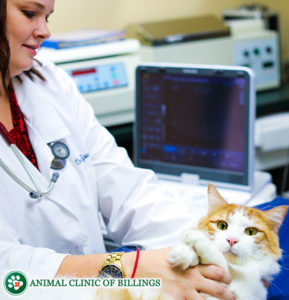 These are diseases of the heart muscle tissue itself. The most commonly encountered cardiomyopathy in cats is called Hypertrophic Cardiomyopathy. Hypertrophic Cardiomyopathy (HCM) causes thickening of the walls of the left ventricle of the heart (the main chamber pumping oxygenated blood out to the body), which decreases the volume of blood than can enter and leave the heart with each beat.
These are diseases of the heart muscle tissue itself. The most commonly encountered cardiomyopathy in cats is called Hypertrophic Cardiomyopathy. Hypertrophic Cardiomyopathy (HCM) causes thickening of the walls of the left ventricle of the heart (the main chamber pumping oxygenated blood out to the body), which decreases the volume of blood than can enter and leave the heart with each beat.
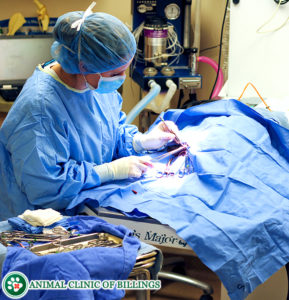 The backup of blood behind the left ventricle causes dilation of the upstream chamber (the left atrium) and stretching of the valve between these two chambers. Backflow through this valve exacerbates the heart’s difficulty in delivering sufficient blood to the body and predisposes the patient to the formation of blood clots, which can lodge in blood vessels throughout the body, a potentially fatal complication.
The backup of blood behind the left ventricle causes dilation of the upstream chamber (the left atrium) and stretching of the valve between these two chambers. Backflow through this valve exacerbates the heart’s difficulty in delivering sufficient blood to the body and predisposes the patient to the formation of blood clots, which can lodge in blood vessels throughout the body, a potentially fatal complication.
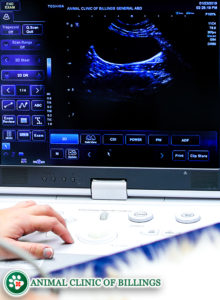 This disease has a genetic basis in the Maine Coon and Ragdoll, although it is seen in many domestic shorthair/mixed breed cats as well. In a minority of cases, HCM is caused by hyperthyroidism. Symptoms can be very subtle and include an increase in resting respiratory rate and a decreased activity level. The diagnosis of HCM requires an echocardiogram.
This disease has a genetic basis in the Maine Coon and Ragdoll, although it is seen in many domestic shorthair/mixed breed cats as well. In a minority of cases, HCM is caused by hyperthyroidism. Symptoms can be very subtle and include an increase in resting respiratory rate and a decreased activity level. The diagnosis of HCM requires an echocardiogram.
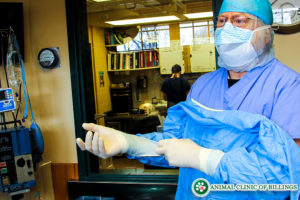 This disease is not curable, but with appropriate medications, the progression of the disease can be slowed. Prognosis is best in cases that are detected early in the course of illness.
This disease is not curable, but with appropriate medications, the progression of the disease can be slowed. Prognosis is best in cases that are detected early in the course of illness.
Another cardiomyopathy, Dilated Cardiomyopathy, is now rare in cats but used to be common before the addition of the amino acid taurine to cat food. This disease causes weakening and stretching of the heart muscle, rendering it unable to pump blood efficiently, and resulting in congestive heart failure. It is still occasionally seen in cats being fed a taurine-deficient diet.
Arrhythmias
Arrhythmias are abnormal patterns of electrical activity within the heart. In cats, most arrhythmias develop secondary to one of the above disease processes, as the electrical wiring of the heart becomes stretched or distorted. The most common symptoms of clinically significant arrhythmia are exercise intolerance and collapse/fainting.
Arrhythmias are diagnosed using an ECG; sometimes, a short ECG lasting only a few minutes is sufficient to make a diagnosis. In other cases a 24-hour-long ECG (called a Holter Monitor study) is necessary. Most arrhythmias in cats can be effectively managed with anti-arrhythmic medications.
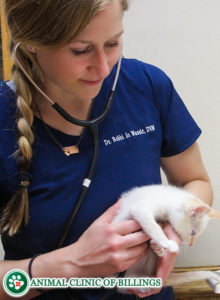
SYMPTOMS OF HEART PROBLEMS IN CATS
Possible symptoms of cat heart problems that cat owners should be on the lookout for include:
- Lethargy/weakness
- Decreased activity
- Sudden paralysis of the hindquarters
- Fainting/collapse
- Chronic coughing
- Rapid or labored breathing
If you see any of these symptoms, scheduling an appointment with our veterinarians immediately.
406-252-9499
DIAGNOSING HEART DISEASE IN CATS
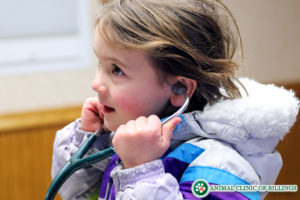
Diagnosing heart disease in cats begins with a physical examination followed by diagnostic tests:
Echocardiogram
An echocardiogram is an ultrasound of the heart. This non-invasive test uses sound waves to generate a real-time image of the heart, enabling precise evaluation of wall thickness, chamber sizes, efficiency of contractions, and valve structure and function.
Blood pressure
A standard, non-invasive blood pressure test is performed to monitor systolic and diastolic pressure.
Electrocardiogram (EKG)
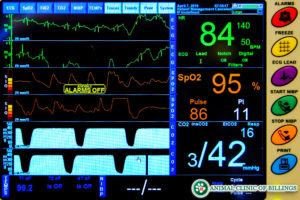 An EKG is performed by attaching several electrodes to the skin surface to record the pattern of the heart’s electrical activity to detect arrhythmias.
An EKG is performed by attaching several electrodes to the skin surface to record the pattern of the heart’s electrical activity to detect arrhythmias.
Chest X-Rays
Chest X-rays provide information about the size and external contours of the heart, which are often altered in the presence of heart disease. They also permit evaluation of the lungs and blood vessels in the chest, which display classic changes in the presence of congestive heart failure.
Bloodwork
Typically, a minimum database consisting of a CBC, serum chemistry, and thyroid level are evaluated in a cat showing signs of heart disease. This is important for two reasons: to assess any impact their heart disease may be having on their other organ systems, and to check for the presence of hyperthyroidism, which can cause hypertrophic cardiomyopathy over time.
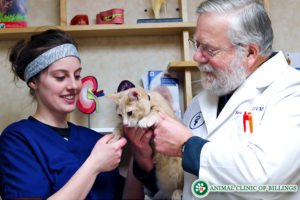
TREATMENT OF HEART DISEASE IN CATS
While heart disease in cats is typically not curable, it can be managed with medications that slow down the progression of disease and minimize the symptoms and impact on a patient’s quality of life. Periodic testing will be necessary to reassess heart function and make adjustments to the patient’s medications.
When one of our veterinarians institutes a treatment plan for heart disease in a cat, they will explain to the owner what signs to monitor for at home and how frequently the patient needs to be reevaluated.
POSSIBLE COMPLICATIONS OF HEART DISEASE IN CATS
In addition to the development of congestive heart failure, several other complications may arise in cats with heart disease. In Hypertrophic Cardiomyopathy, it is not unusual for a large blood clot to form within the heart, and when fragments of this clot escape into the circulation, they can become lodged in blood vessels, preventing oxygen delivery to associated tissues.
One classic location for deposition of these clots is where the aorta divides to provide blood flow to the hindlimbs. If this occurs, the patient will rapidly lose the ability to use their hindlimbs and will be quite painful. With intensive supportive care, a minority of these patients will be able to restore circulation before irreversible damage occurs.
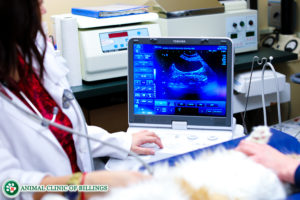 Because of the poor prognosis and high likelihood of surviving patients to experience another clot, euthanasia must be considered in these situations. Patients with HCM can also develop arrhythmias associated with the structural changes that occur within the heart. If recognized, these can usually be controlled with anti-arrhythmic medications for variable periods.
Because of the poor prognosis and high likelihood of surviving patients to experience another clot, euthanasia must be considered in these situations. Patients with HCM can also develop arrhythmias associated with the structural changes that occur within the heart. If recognized, these can usually be controlled with anti-arrhythmic medications for variable periods.
PROGNOSIS FOR CATS WITH HEART DISEASE
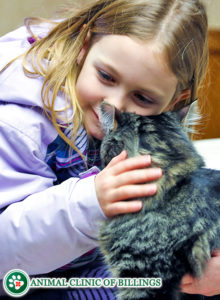 Although heart disease in cats is not usually curable, with appropriate treatment, the progression of disease can be slowed down, and the impact on a cat’s quality of life can be minimized. In general, patients who are diagnosed and started on appropriate medical treatment early in the disease process—ideally before symptoms even develop—will have a better response to treatment and long-term prognosis. This is one reason that routine wellness exams are so important.
Although heart disease in cats is not usually curable, with appropriate treatment, the progression of disease can be slowed down, and the impact on a cat’s quality of life can be minimized. In general, patients who are diagnosed and started on appropriate medical treatment early in the disease process—ideally before symptoms even develop—will have a better response to treatment and long-term prognosis. This is one reason that routine wellness exams are so important.
HOW TO SCHEDULE A CARDIOLOGY TESTS FOR YOUR CAT
If you suspect your cat may be suffering from a heart condition, please contact us immediately to schedule an appointment today.
406-252-9499
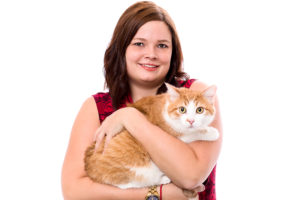
Let our highly trained and experienced team of veterinarians and veterinary technicians help you keep your cat as happy and healthy as they can be.
Call the Animal Clinic of Billings and Animal Surgery Clinic to schedule your cats next wellness examination with us today!
406-252-9499
ANIMAL CLINIC OF BILLINGS AND ANIMAL SURGERY CLINIC
providing our region’s companion animals and their families what they need and deserve since 1981
1414 10th St. West, Billings MT 59102
406-252-9499



